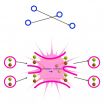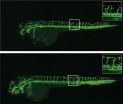(Press-News.org) SALT LAKE CITY- As part of a multi-institutional effort, researchers with Huntsman Cancer Institute at the University of Utah have found that multiple myeloma patients with a genetic variation in the gene FOPNL die on average 1-3 years sooner than patients without it. The finding was identified with a genetic mapping technique, genome wide association studies (GWAS), and verified in patient populations from North America and Europe. This was the first study to survey the entire human genome for genetic variation influencing survival, and included a total of 1,635 patients.
Published in Nature Communications, the results are a step toward applying precision medicine to multiple myeloma, a cancer that affects bone marrow plasma cells that help coordinate the body's immune response. Although relatively rare, the disease is aggressive and incurable, with 43 percent of patients dying within five years of diagnosis. Future studies will focus on finding therapies that improve prospects for this newly identified subset, which makes up an estimated 10-14 percent of multiple myeloma patients.
"This is the largest study of inherited genetics and myeloma survival to date. We were able to identify the FOPNL variant because it has quite a large effect on survival. With even larger collaborative studies, we hope to add to this," says Nicola Camp, Ph.D., Huntsman Cancer Institute investigator, professor of medicine and human genetics at the University of Utah School of Medicine, and Chair of the International Multiple Myeloma Consortium. "The ability to stratify patients based on their genetic make-up opens the door to personalizing their treatment and care."
Camp led the study together with Elad Ziv, M.D., at the University of California, San Francisco (UCSF), Celine Vachon, Ph.D., at the Mayo College of Medicine Rochester and Federico Canzian, Ph.D., from the German Cancer Research Center. The collaboration includes contributions from 38 scientists at 18 institutions and reports on patient data from clinics across Utah, UCSF, the Mayo Clinic, and several European centers in Italy, Poland, Spain, France, Portugal and Germany.
Although the researchers don't yet understand why the genetic variation in FOPNL is associated with poor prognosis, there are clues that it could be involved in disease progression through centrosome amplification. Analysis of separate multiple myeloma patient datasets show that those with the worst outcomes have abnormal amounts of FOPNL, and carry another sign of poor prognosis, a high centrosome index. The implication is that disruptions in FOPNL could affect fundamental mechanisms controlling the distribution of genetic material to newly made cells.
"The results point us to a previously unrecognized gene as a determinant of myeloma prognosis. If we understand what about this gene is causing poor prognosis, that may lead to a better fundamental grasp of the pathways that are important of multiple myeloma progression," says first author Elad Ziv, M.D, a professor of medicine at UCSF. "Such knowledge could ultimately lead to better therapies."
INFORMATION:
The Utah research was supported by the Huntsman Cancer Institute (HCI), the HCI Cancer Center Support Grant P30 CA042014, Leukemia & Lymphoma Society, National Institutes of Health, National Cancer Institute SEER, Utah State Department of Health, and University of Utah. Other research within the study was supported by Steve and Nancy Grand Multiple Myeloma Translational Initiative, Expression Analysis, the National Cancer Institute, Polish Ministry of Science and Higher Education, and the The Research Fund at Region Sjælland, Denmark.
"Genome-wide association study identifies variants at 16p13 associated with survival in multiple myeloma patients" was published in Nature Communications on July 22, 2015.
About Huntsman Cancer Institute at the University of Utah
Huntsman Cancer Institute (HCI) is one of the world's top academic research and cancer treatment centers. HCI manages the Utah Population Database - the largest genetic database in the world, with more than 16 million records linked to genealogies, health records, and vital statistics. Using this data, HCI researchers have identified cancer-causing genes, including the genes responsible for melanoma, colon and breast cancer, and paraganglioma. HCI is a member of the National Comprehensive Cancer Network (a 26-member alliance of the world's leading cancer centers) and is a National Cancer Institute-Designated Comprehensive Cancer Center. HCI treats patients with all forms of cancer and operates several high-risk clinics that focus on melanoma and breast, colon, and pancreas cancers. The HCI Cancer Learning Center for patient and public education contains one of the nation's largest collections of cancer-related publications. The institute is named after Jon M. Huntsman, Sr., a Utah philanthropist, industrialist, and cancer survivor.
A test of the Mobile Bridge® Version 4.0 (MB4.0) over a real river demonstrated its viability for practical use. During the test, the bridge was set up without any foundation work, and a vehicle could easily travel across it. This was achieved safely with very few people and without any problems. The MB4.0 viability test results were presented at a symposium of the Japan Society of Civil Engineers (JSCE) on June 23, 2015, by Dr. Ichiro Ario, Assistant Professor at the Institute of Engineering, Hiroshima University.
Background of developing MB:
Natural disasters include ...
A new theory says dark matter acts remarkably similar to subatomic particles known to science since the 1930s.
We owe a lot to dark matter - it is the thing keeping galaxies, stars, our solar system, and our bodies intact. Yet no one has been able to observe it, and it has often been regarded as a totally new exotic form of matter, such as a particle moving in extra dimensions of space or its quantum version, super-symmetry.
Now an international group of researchers has proposed a theory that dark matter is very similar to pions, which are responsible for binding atomic ...
Bethesda, MD (July 22, 2015) -- Newborn children born with a mutation in the Plasmalemma Vesicle Associated Protein (PLVAP) gene develop severe protein losing enteropathy, according to a case study1 published in Cellular and Molecular Gastroenterology and Hepatology, the basic science journal of the American Gastroenterological Association. Protein losing enteropathy is a condition of the GI tract that results in loss of protein from the body, and often leads to severe abdominal swelling, malnutrition and early death in affected infants
The investigators utilized next-generation ...
This news release is available in German.
New methods for modifying the genome are currently widely discussed: Using CRISPR/Cas for instance, scientists can remove parts of the genetic code of a gene, thereby knocking it out. Furthermore, there are ways to inhibit translation of a gene into a protein. Both methods have in common that they impede production of a protein and should therefore have comparable consequences for an organism. However, it has been shown that consequences can differ, after a gene is either knocked, out or only blocked. Scientist from the ...
Levels of biomarkers in the blood of pregnant women can be used to predict which women are at risk of pre-eclampsia, finds a study published today (22 July) in BJOG: An International Journal of Obstetrics and Gynaecology (BJOG). ADMA and Hcy, both known to be raised in women with pre-eclampsia, are present in the blood in higher than normal concentrations a month before the onset of the condition.
Pre-eclampsia is a combination of raised blood pressure (hypertension) and protein in the urine (proteinuria). It is quite common, usually occurring after 20 weeks of pregnancy, ...
Scientists at Lawson Health Research Institute have uncovered an important new target for ovarian cancer therapy. Contrary to current research this new study found that LKB1, a molecule that regulates the metabolism of many adult cells, is an important molecule in the cancer's promotion and survival.
Thousands of women are living with ovarian cancer in Canada. It is estimated that this year, 2,800 Canadian women will be newly diagnosed with this disease. Even though ovarian cancer continues to be one of the most serious women's cancers, there is a real lack in reliable ...
Patients suffering from chronic cardiopulmonary diseases could soon have a solution to help them accurately monitor their health and warn doctors at the first sign of trouble.
By simply carrying their cellphone, equipped with the health-tracking app, MoveSense, developed by researchers at the University of Illinois at Urbana-Champaign, a patient's oxygen saturation level can be passively monitored with medical accuracy.
Oxygen saturation is a standard measure of health status, the single most important clinical measure. Unlike other methods of measuring oxygen saturation ...
Roughly 20 to 30 percent of patients with hepatitis C virus (HCV) are also infected with human immunodeficiency virus type 1 (HIV). Both blood-borne viruses share the same modes of transmission, but many HCV medications currently have significant limitations due to adverse interactions with HIV treatments. Researchers at University of California, San Diego School of Medicine report a new combination that effectively treats HCV in patients co-infected with HIV.
The study, published online in the New England Journal of Medicine, found the combination of HCV drugs daclatasvir ...
Smokers who successfully lowered their nicotine intake when they were switched to low-nicotine cigarettes were unable to curb their smoking habits in the long term, according to a study by researchers at UCSF and San Francisco General Hospital and Trauma Center.
The study, published online today (July 22) in the journal Addiction found that levels of cotinine, a derivative of nicotine measured in the blood, plummeted six months after smokers' regular cigarettes were replaced with low-nicotine ones. But levels started to rebound later into the study when smokers returned ...
You may have never seen or heard of it, but hair ice - a type of ice that has the shape of fine, silky hairs and resembles white candy floss - is remarkable. It grows on the rotten branches of certain trees when the weather conditions are just right, usually during humid winter nights when the air temperature drops slightly below 0°C. Now, a team of scientists in Germany and Switzerland have identified the missing ingredient that gives hair ice its peculiar shape: the fungus Exidiopsis effusa. The research is published today (22 July) in Biogeosciences, an open access ...




